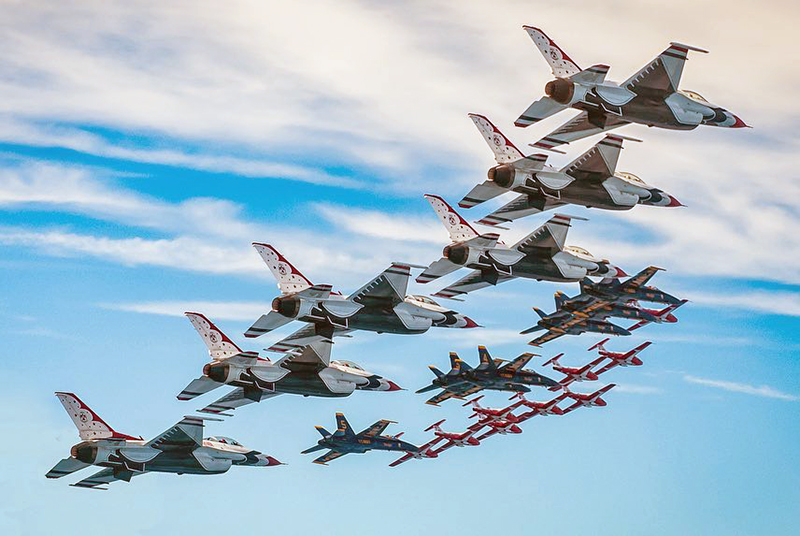Unique One-Time Mass Formation Over Lake Erie Captured by Photographer Glenn Watson.
In what is certainly one of the most spectacular aerial photo shoots in aviation history, photographer and pilot Glenn Watson captured amazing photos of the U.S. Navy Blue Angels, the U.S. Air Force Thunderbirds and the Canadian Forces Snowbirds jet demonstration teams flying together in one massive formation last Thursday, August 30, 2018 over the Midwestern United States.
It is likely the first and probably the last time this unique formation of 21 aircraft (23 total aircraft including support planes) could ever be photographed flying together in formation. Watson told us in an exclusive interview the incredible photo shoot was planned in advance nearly a year ago.
“’Feed’ (Call sign for Blue Angel #5) and ‘Naughty’ (Call sign for Snowbird #10) hatched the idea last year at ICAS [The International Council of Air Shows- Ed.]. Then, one step at a time, the mission was planned and with excruciating detail sent up for approval. I’m normally involved in the logistical planning of local flights, but with the complexity and widely spread out nature of this one almost all of this particular mission planning took place inside the military between the three teams. Lots of moving parts with 23 jets, 3 teams launching from 3 different places,” photographer Glenn Watson told TheAviationist.com.
Aerial photography specialist Glenn Watson is from Mach Point One Aviation Photography based in central Texas. To get these unique photos he joined the teams, flying in the back seat of a two-seat Boeing F/A-18D Hornet belonging to the U.S. Navy Blue Angels flight demonstration team as Blue Angel #8. The aircraft was flown by U.S. Navy Lieutenant Andre Webb of Lawton, Oklahoma. Lt. Webb is actually Blue Angel #7 himself, and has over 2,100 flight hours and 200 arrested carrier landings.
The team of photographer Glenn Watson and Lt. Andre Webb flew off the right wing of the converging group of aircraft as they rendezvoused over Lake Erie near the Canadian/U.S. border.
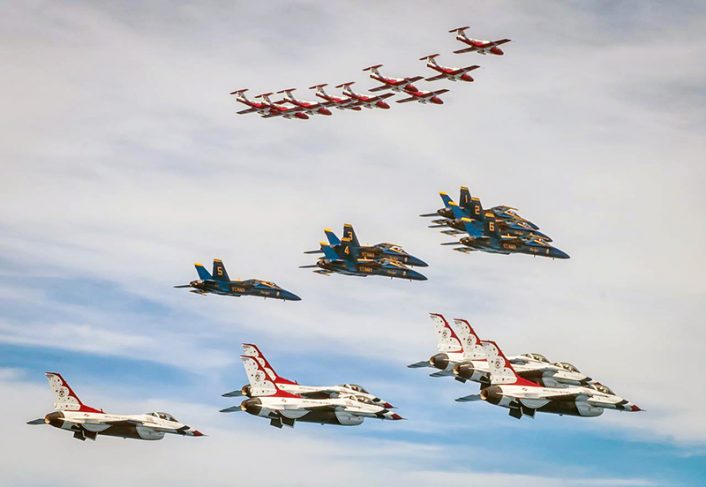
“It was all planned with primary focus on flight safety – precise altitude deconfliction and route planning so the elements flew in their own “lanes” and never passed behind one another and encountered wake turbulence or jet wash,” Watson told TheAviationist.com.
The 21 aircraft formed up in their precisely arranged “stair step” formation initially with smoke on so the aircraft could visually acquire each other for the link-up. The Canadian Forces Snowbirds, the 431st Air Demonstration Squadron, took the top position in their CT-114 Jet Tudors with nine aircraft, the largest number of team aircraft in the photo formation. Stacked below the Snowbirds was the U.S. Navy flight demonstration team, the Blue Angels, in six Boeing F/A-18C Hornets. Flying trail in the formation at the low edge of the stair-step formation were six single seat General Dynamics F-16Cs from the USAF Thunderbirds.
Watson himself is uniquely qualified for such an extraordinary photo shoot since he is, in addition to being a professional photographer, a pilot himself who is certified in formation flying. This technical insight by Watson enables him to work safely and effectively with other aircraft in formation flight and to communicate efficiently with his photo platform pilot, Lt. Andre Webb.
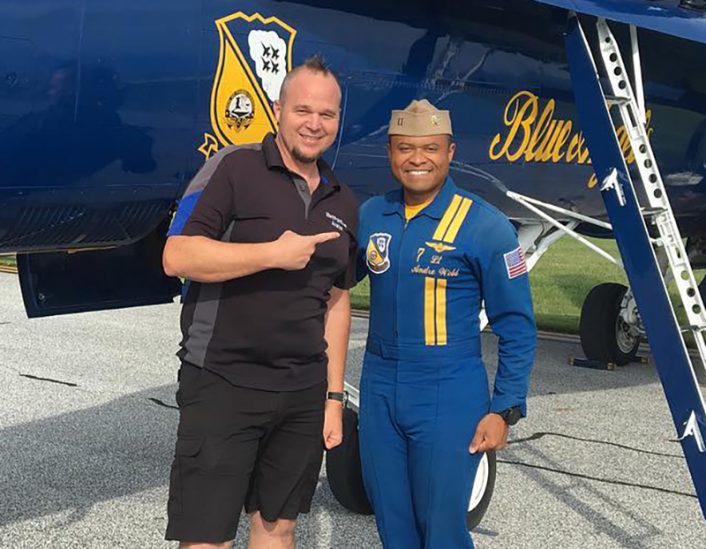
“Once we all joined, the photo ship, Blue Angel #7 with me [photographer Glenn Watson] in the back, would maneuver around the elements to get the various angles. The plan was the three full team elements making left turns, 30-mile legs lined up in order of most available power on the outside of the turn. No formation changes or position changes were planned besides slight adjustments to spacing between elements for symmetry,” said Glenn Watson.
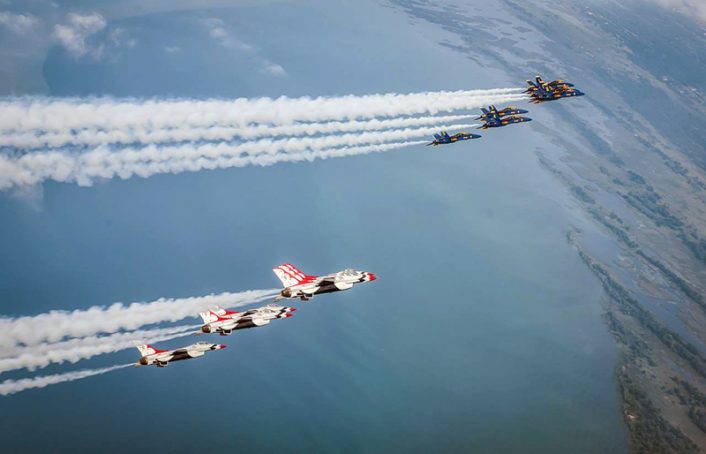
Lt. Andre Webb and Glenn Watson continued to fly to the right of the converging formation throughout the shoot and varied altitude relative to the huge 21-plane group to get the unique photos.
Watson used his trusty Nikon D810 DSLR camera body with a 24-70mm/f2.8G zoom lens for these shots. “That combo is my go-to still image kit for 80% of my work, with a D810 and 70-200mm/f2.8 VR covering the rest.”
While every aviation photographer in the world would no doubt jump at the chance to photograph such a formation, only a uniquely qualified pilot and photographer like Glenn Watson has the combination of technical skills and creative insight to optimize such a unique and dynamic opportunity.
Watson told us after the photo shoot, “I think being a pilot helps for all my work because you have a better idea of what is possible to do with an airplane, and what is required to put the airplanes in the various attitudes for the shots. Some spots may be blind, or have no “out” and it helps to fully understand that and therefore not ask pilots to move into those spots for photos.”
The risks involved in mass photo shoots of dissimilar aircraft are very real, as tragically demonstrated in the June 8, 1966 midair collision of a NASA F-104N Starfighter and a USAF XB-70 Valkyrie heavy bomber during a publicity photo shoot for jet engine manufacturer General Electric over Barstow, California. The tragic accident during the formation photo shoot left two experienced test pilots dead and two advanced aircraft burning in the desert near Edwards AFB.
“It’s definitely hard to comprehend everything that is going on during a shoot like this, and when you’re in charge of directing it there is no time to think up there. If you think, you’re dead. (‘TOP GUN’ Quote of course). Basic operation of your gear and exposing the photos properly has to be second nature. Positioning the aircraft in the right place for the sun angle, keeping equipment contained inside the jet and not interfering with controls, moving the formations around to line them up in real-time, and anticipating what the aircraft may be doing next, all while pulling G’s and yanking and banking in the back of a fighter jet takes all your concentration. Most of these jet photo shoots’ time together is very limited and once they’re “in” you start firing away and execute the shot list as fast as possible. It’s pretty scary to think about, but on many flights when it’s ‘photo X’ complete and the subjects detach (and I start breathing again) I realize I never looked at the back of my camera a single time- I just get in the zone and you can feel when it’s working,” Glenn Watson said.
After Watson’s incredible images began to go viral across social media only hours after the shoot was over the significance of what he achieved in the context of aviation history became apparent. It was also apparent that very few other aviation photographers could have captured the incredible images the way Glenn Watson did.
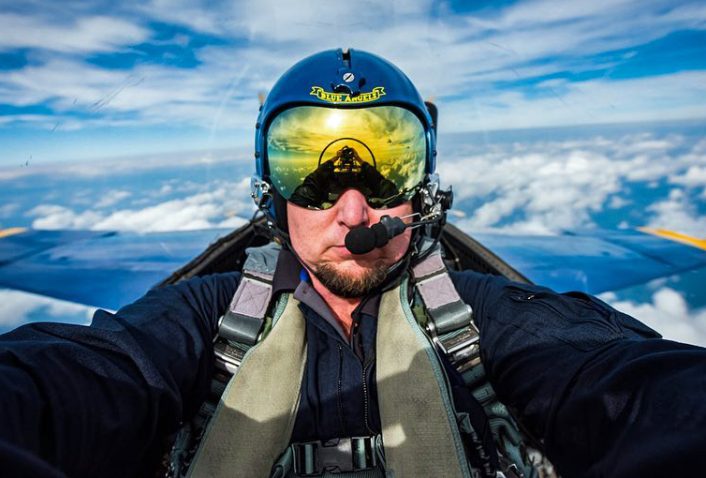
“Formation flying is all about trust – I have been working tirelessly the last 4 years building a relationship with the Blues and proving to them that me and my team are also top professionals and can be trusted to get the shots and return to base safely. The Blue Angels have always been heroes of mine, and being asked by them to capture these historic photos was the highest honor. I have been a Blue Angel guy since I was a kid and for me sitting in their briefing room, being included in the preflight briefing, the walk down to the jets, and then shaking hands with each pilot in line after the flight was a highlight of my life.”
In seeing the final product of Glenn Watson’s photography and the impressive planning and precision flying of the Snowbirds, Blue Angels and the Thunderbirds it’s reasonable to suggest that Watson’s photos may be the highlight of not only the 2018 air show season, but of many seasons to come.
Thanks to aviation photographer and pilot Glenn Watson for his interview. Watson’s website for viewing and booking his aerial photography and all contacts is: www.machpointoneaviation.com

